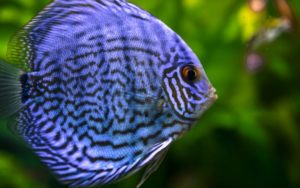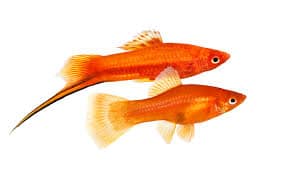
Freshwater fish are creatures that belong to the group of vertebrates, which live in the depths of rivers, lakes, among other freshwater channels around the world.

They are capable of withstanding large temperature changes due to anatomy of their body.
Before entering fully into the topic of freshwater fish we want to provide you with information regarding the different types of waters.
Table Of Content
- 1 Types Of Waters
- 2 Freshwater fish: Characteristics
- 3 Evolution.
- 4 Freshwater fish: Feeding Habits
- 5 How Freshwater Fish Reproduce?
- 6 Distribution and habitat.
- 7 Types of freshwater fish.
- 8 Discus fish.
- 9 Gourami fish.
- 10 Scalar fish or angelfish.
- 11 Goldfish.
- 12 Freshwater fish with Exotic Names
- 13 Edible freshwater fish.
Types Of Waters
Fresh water is water that contains minimal amounts of dissolved salts, (especially sodium chloride), thus distinguishing it from salt water (sea water). Fresh water is the water of rivers and lakes.
Saltwater is water that can be found in Earth’s oceans and seas. It’s salty due to the concentration of dissolved mineral salts it contains, an average of 35 ‰ (3.5%), among which sodium chloride predominates
Brackish water is water that has more dissolved salt than fresh water, but less than sea water.
Technically, brackish water is considered to be that which has between 0.5 and 30 grams of salt per liter, more frequently expressed as 0.5 to 30 parts per thousand.
Let’s watch this really interesting video…
Freshwater fish: Characteristics
As we have previously mentioned, freshwater fish are living beings that develop mainly in rivers, lakes, and lagoons.
This type of habitat is somewhat small but spacious enough for them to survive comfortably.
They have special gills that help them regulate their temperature in the water, their body is usually covered by scales that regulate low temperatures.
In their anatomy you can also see some scales throughout their body that allows them to have better mobility.
Evolution.
Their evolution is a subject that is still under discussion by many experts, since an exact time is not yet known in which it demonstrates the beginnings of the freshwater fish.
Since these beginnings little by little the structure of such fish  changed, and different investigations and studies have shown that their anatomy has been altered over the years.
changed, and different investigations and studies have shown that their anatomy has been altered over the years.
Today there are smaller and more varied species depending on the families to which they belong.
Anatomy.
In the case of the freshwater fish, their anatomy depends on the water where they are developing. Since not all waters are the same, some are denser than others with which each type of fish adapts little by little.

They have the same body aspect as most vertebrates, their characteristics may vary depending on the species to which they belong, their body is made up of a head, trunk or abdominal area and a tail.
Their head contains branchial areas which allow them to store the greatest amount of oxygen and to be able to breathe properly in the water.
It’s worth mentioning that their trunk or abdomen houses most of their organs where a pair of fins can also be seen which give them greatest possible mobility in the water.
The tail represents another extra complement to its anatomy, since in the company of the dorsal fins in the trunk area are the ones that provide all the movement to freshwater fish, allowing them to reach the necessary speed to move along and width of the waters where they coexist.
Their skin like other vertebrates contains special characteristics, since most freshwater fish are covered by scales which are what allow them to resist the different temperature changes to which they are continuously exposed.
Although not all species have scales on their bodies some freshwater fish species contain another type of structure very similar to scales that performs the same function.
Let’s enjoy this wonderful video
Https://www.youtube.com/watch?v=U9uxHz6MWCs
Freshwater fish: Feeding Habits
The freshwater fish’ diet only depends on what is in its habitat and the nutrients that they provide for them; and therefore it causes that the feeding habits of the fish are very diverse and can vary according to the case.
The diet can also vary according to the species that is being treated, since there are diversity of families that feed on various types of food in the water, be they carnivores, herbivores, among other categories.
Carnivorous freshwater fish.
This type of freshwater fish species feeds specifically on smaller fish, but at the same time they can consume any type of species that inhabit the water, such as insects and mollusks.
Yet, the latter is not very common among them and only occurs when they need it. 
There are different types of fish that develop certain characteristics that allow them to ingest their food completely, many are considered carnivorous fish only for ingesting insects that live in the waters.
The peculiarity of them is that only in fresh water do they consume insects and for them are part of this category.
Herbivorous freshwater fish.
This type of food is the most common in the category of freshwater fish, since what is most abundant in this type of water is algae and plants which provide them with a large amount of nutrients they need to survive.
Although this type of food abounds for these fish, they are the most difficult to digest for them, since their content is so heavy that they cause the digestive system to keep working all day.
The studies carried out on this type of species have concluded that most freshwater fish that consume this type of food usually supplement their diet with some live species, that is, they can also become carnivores, for the sole purpose to improve their digestion to obtain better mobility in the water.
Omnivorous freshwater fish.
This category represents the diet of most freshwater fish, since they seek to complement their diet with both plants and living things. Despite the fact that these fish don’t eat the same foods that  carnivorous fish consume, they prefer to feed on other types of species and not on other fish.
carnivorous fish consume, they prefer to feed on other types of species and not on other fish.
The best example of omnivorous freshwater fish are piranhas which despite the fact that the world knows them as one of the most ruthless carnivorous species, since they also usually supplement their diet with various vegetables found in the fresh waters of the Amazon where they develop.
How Freshwater Fish Reproduce?
The reproductive patterns doesn’t vary no matter the species we are talking about; whether they are freshwater or saltwater fish, their reproduction is the same.
This occurs in certain periods of time, which could be every month or every year, depending on the species and external factors in those that develop like temperature and food.
Freshwater fish have their sexuality well marked, since there are males and females, although there are species whose sex changes suddenly, but this doesn’t happen very in the case of freshwater fish.
The distinction of sex between fish is not easy since its reproductive system is not in plain sight to be able to conclude whether it’s male or female.
The only way that has been found and thanks to different studies is that males and females They can be differentiated by the coloration of their skin or by the anatomy of the species as the case may be.
Oviparous reproduction.
This type of reproduction in freshwater fish is generated when the female expels the eggs in the middle of the water, which is called external fertilization,although there are many oviparous species that prefer to create nest species to protect their eggs which are created mostly by the male which stores them in a kind of bubble until the egg fertilizes and hatches.
Ovoviviparous reproduction.
This type of reproduction occurs with the combination of various unusual characteristics . It really worth mentioning that ovoviparous reproduction, is carried internally between males and females, causing the fertilization of the eggs to take place in their womb, but when they are hatched they are already be formed species.
The peculiarity of this type of fertilization is that the females can become pregnant several times without a male to penetrate them.
Distribution and habitat.
Most of the freshwater fish are found among the rivers and lakes around the world.
This is due to their distribution, but if we refer to their habitat, this is a slightly more limited aspect because over the years and the hand of man, intervening at different points for the exploitation of certain natural riches, have mostly damaged the natural habitat of freshwater fish.
Diversity of freshwater fish can be found mainly in the different rivers of North and South America, the same waters being the most appropriate to house the different species.
Yet, due to the invasion of man to their habitat many conservative foundations have been seen in the need to move them to much colder areas such as North Asia and Europe respectively.
Let’s enjoy this wonderful video
Types of freshwater fish.
It’s no secret to anyone and although they have a limited habitat, a great diversity of freshwater fish species are known, which develop throughout the rivers and lakes where they usually develop.
Discus fish.
This is one of the most valued freshwater fish, since they are the most expensive in terms of capturing and being placed in captivity.
Discus fish are from South America and their name is due to their body’s shape which is a little rounded and flattened simulating a real disk.. Their body has a diversity of colors and designs that make it very striking to the eye.
These fish need very specific external conditions and factors to reproduce.
For this to happen, they are fish that do not tend to fertilize constantly and even more so when they are in captivity, and what makes it even more complicated is that this species is very difficult to distinguish between male and female since both at the anatomy level are very similar. We invite you to read our article discus fish to learn more about this species
Gourami fish.
This type of fish can be found anywhere in the world, especially in lakes and lagoons. Gouramis are considered ideal fish to keep in captivity since they can be adapted to any environment.
They have as a special feature (their second respiratory organ), which helps them to surface and breathe properly without putting  themselves at any risk when doing so.
themselves at any risk when doing so.
It’s worth mentioning that they have whiskers on their snouts that function as sensory organs when feeding.
Its reproduction is based on the creation of nests with bubbles, which are made by the male after fertilizing the female.
After this process, the male shelters his eggs since there is the possibility that the female will eat them herself.
The nesting process of the eggs lasts at least 3 during which the male moves away so that there is no risk of him eating his young. We invite you to read our article gourami fish to learns more about this interesting topic.
Scalar fish or angelfish.
This peculiar species of freshwater fish (also called angelfish) comes from the Amazonian waters, and they enjoy deep waters.
Angel fish are considered one of the favorite freshwater fish when it comes to capturing them for their captivity as their color diversity makes them very interesting.
They have a peculiar characteristic when swimming, since they don’t do it like other species, their style of swimming is slow and vertical, which simulates as if it were floating in the water, many say that they may look like sea angels
As for their reproduction, they are a species of freshwater fish that is very difficult to distinguish in terms of sex.
The females usually deposit their eggs in vertical plants that are in the water and after this stage they stay away since it is many times they usually eat their young without knowing it.
Swordtail fish.
This fish is mainly characterized because the male develops a longer tail than the rest of the species.
It’s worth noting that they are omnivorous fish that feed on algae, larvae or bacteria that are found around the waters where it develops.
Their reproduction occurs internally and it’s not difficult to differentiate males from females. the female fertilizes her offspring in her womb and when the time comes that they are born frees them already formed.
When this happens, the mother tends to move away but they run a great risk of other fish eating them, although they are born with defense instincts and are cape and can perceive the danger that manifests itself around them.
Goldfish.
The goldfish is one of the most coveted freshwater fish in the world to keep in captivity, as it’s considered an ideal pet.
They can be found in large quantities in the Asian rivers since their species comes from there.
This type of freshwater fish usually consumes large amounts of oxygen while swimming and preferably they operate in shallow waters, but rather warm temperatures.
They are fish capable of consuming large amounts of food despite their size, and are considered omnivorous fish in their entirety, so they can look for food anywhere in the river.
Their reproduction both in its natural state and in captivity will depend on whether the male and female have reached sexual maturity.
This occurs around 2 years of life and for fertilization to occur they must be in waters with suitable temperatures ranging up to 22 degrees.
The female lays her eggs in nests created by the male and in just 3 days they will hatch, which from the moment they hatch are in great danger of being eaten by their parents.
Freshwater fish with Exotic Names
There is a great diversity of freshwater fish, which have such exotic names that it’s difficult for many people to pronounce them. Many are those who do not know certain characteristics of them or who have never heard them since they are not so popular.
Killis fish.
They are freshwater fish with a peculiar name; this species is capable of surviving in different types of waters.
They are fish capable of living together with other fish and animals without them being threatened, their skin is very colorful and they can be put into captivity without any threat to them.ü
Anostomid fish.
They are fish that despite being freshwater can reach a large size since they can measure up to about 20 cm in length, which is a novelty since there are few species of freshwater fish that manage to have large proportions.
It’s worth mentioning that they are fish with an independent behavior, but this does not affect their coexistence with other fish since they are capable of  interacting with them, they don’t react to other animals aggressively, so if they are caught for their captivity there is no nothing to worry about.ü
interacting with them, they don’t react to other animals aggressively, so if they are caught for their captivity there is no nothing to worry about.ü
Calyctid fish.
They are similar to catfish, and like to be in the depths of rivers and lakes. It has the advantage that they are fish that can adapt to different waters and temperatures, just as they can coexist with other species without feeling threatened.
Cichlid fish.
They are fish of a great size although not of great proportions. In its anatomy, it can be seen that black color predominates in its scales and it’s combined with other bright colors which give it that characteristic point.
Cichlid fish are mainly omnivorous fish and they like to feed on the young of other fish and even their young. Their reproduction varies according to the temperature of the water where they are, since if they are very cold waters the female will not be able to ovulate comfortably. We invite you to read our articles ciclid fish to learn more about this interesting species.
Giniroqueílidos.
They are very conventional freshwater fish types. They have a particularity and that is that they have an extra organ that allows them to adhere to the rocks and  algae that are around them.
algae that are around them.
If you prefer to catch them to keep them in captivity, they are very special fish, since they help to keep the fish tanks clean due to the qualities they possess.
Gourami Besucón.
As its name implies, this freshwater fish usually kisses constantly to demonstrate its hierarchy among other fish of the same species. That is their non-violent way of marking the territory with respect to the courtship of the females and they can coexist with other types of species.
They are fish that have a large size and despite being freshwater fish, they can measure around 25 cm. their care in captivity must be adequate since if this does not happen they can harm not only their species but the other fish that are in their company.
Edible freshwater fish.
Few freshwater fish can be consumed by humans.
Let’s learn about them below.
Catfish.
They are practically raised in rivers, and moved to ponds where they can also adapt very well. They are fish that, if well fed, take little time to grow and can weigh up to 680 grams.
Catfish are highly predatory and carnivorous fish as they feed on other species to survive.
We invite you to read our article striped catfish to learn more about this wonderful species.
Tilapia.
They are freshwater fish from Africa and the Middle East. They are very strong fish that, like catfishes, grow rapidly and remain in constant movement.
Many settlers call them aquatic chickens and it is worth mentioning that they are completely omnivorous creatures so it is very easy to raise them since they can practically eat everything.
Tilapia can weigh up to 450 grams when they are in temperatures suitable for their development.
Common Carp
They are fish that can be bred specifically for human consumption, they are taken to ponds where they are raised at temperatures suitable for their development.
They can weigh up to about 27 kilos although most of those that are raised only weigh between 4 and 6 kilos; These fish have the peculiarity of growing very fast, they can reach the desired size and weight in just 2 years in captivity.
Let’s enjoy them
